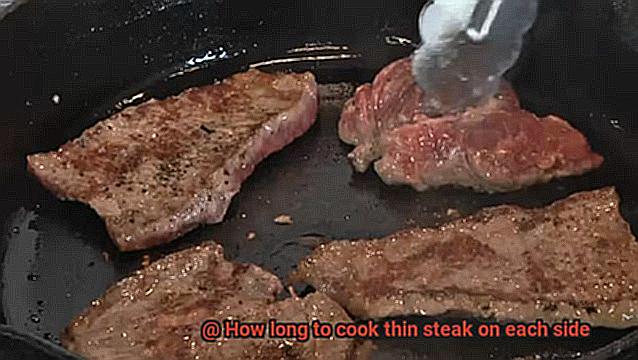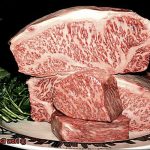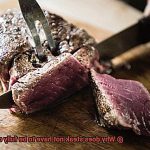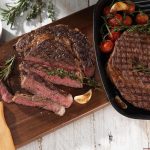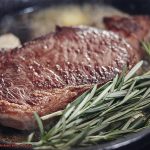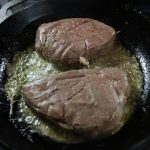Are you craving a mouth-watering, succulent steak but unsure about the cooking time? Cooking a steak may seem like a breeze, but it requires careful consideration of various factors such as thickness, temperature, seasoning and cooking time.
In this blog post, we’ll be focusing on thin steaks – an easier and quicker option to cook. However, even with these cuts, precision is key to ensure that they are cooked to perfection. Thin steaks can be tricky to cook evenly as they can easily become overcooked or undercooked. But fret not. We’re here to help.
We’ll begin by discussing essential factors such as the thickness of your cut of steak, the type of steak and your personal preference for doneness. Next up, we’ll explore the best cooking methods for thin steaks whether it’s on a grill or stovetop and how long to cook them on each side.
By the end of this post, you’ll have all the know-how needed to cook the perfect thin steak every time. So get ready to impress your friends and family with your newfound culinary skills. Let’s dive into the world of thin steak cooking together.
Contents
What Is a Thin Steak?
As a steak aficionado, I’ve learned that cooking a thin steak is an art form. It’s easy to overcook or undercook it and end up with a less-than-perfect meal. But worry not. I’ve got some tips and tricks to help you cook a thin steak to perfection every time.
First things first, let’s talk thickness. A thin steak is typically around 1/2 to 3/4 inches thick, which means it requires a shorter cooking time than thicker cuts. To achieve medium-rare doneness, aim for approximately 2-3 minutes of cooking time on each side. If you like your steak more well-done, add an extra minute or two on each side.
However, keep in mind that cooking times can vary depending on the cooking method used. For instance, grilling your steak will require less cooking time as the heat from the grill is much higher than that of a stovetop. Conversely, if you’re cooking your steak on a lower heat stovetop or in the oven, you may need to increase the cooking time slightly.
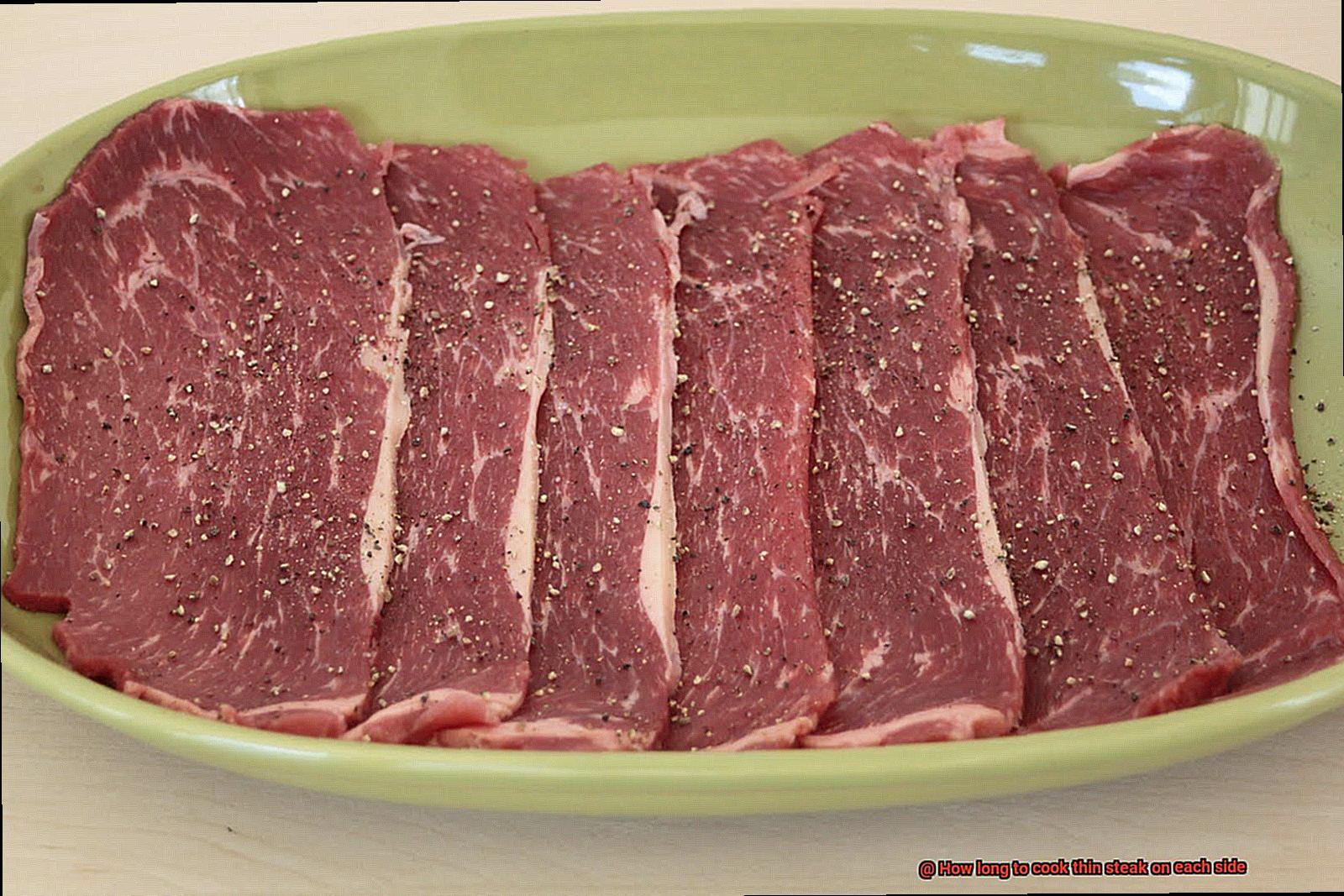
When selecting your cut of meat, choose one that’s evenly thin and has some marbling throughout. This will ensure that your thin steak cooks evenly and stays juicy. Thin steaks can come from various cuts of beef, including sirloin, flank, and even ribeye. Keep in mind that these cuts tend to be leaner than thicker cuts like porterhouse or T-bone, which means they cook faster but also have less marbling for flavor.
To ensure that your thin steak is cooked perfectly on both sides, use a meat thermometer to check its internal temperature. For medium-rare doneness, the internal temperature should be around 135°F (57°C). For medium doneness, it should be around 145°F (63°C). Once you’ve reached your desired temperature, remove the steak from the heat and let it rest for a few minutes before slicing and serving.
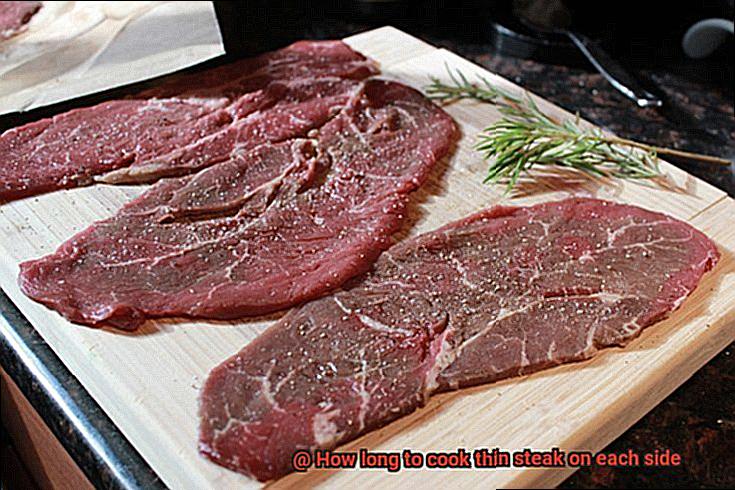
In summary, cooking a thin steak requires finesse and attention to detail, but it’s not difficult once you know the tricks. Remember to adjust cooking times based on thickness, choose a cut with some marbling for flavor, and use a meat thermometer to check internal temperature.
How Long Should You Cook a Thin Steak on Each Side?
Timing is everything when it comes to cooking the perfect steak. Overcook it and you’ll end up with a tough and chewy piece of meat, undercook it and you risk food poisoning. So, how long should you cook a thin steak on each side? Let’s dive in.
The thickness of your steak will determine the cooking time. A thin steak, which is usually less than an inch thick, cooks faster compared to a thicker cut. The level of doneness you prefer also plays a significant role in cooking time. If you like your steak rare, it will take less time to cook than a well-done steak.
Now, let’s get to the specifics. For a thin steak that’s around ½ inch thick, cook it for 1-2 minutes on each side for rare, 2-3 minutes on each side for medium-rare, and 3-4 minutes on each side for medium. If you prefer your steak well-done, then cook it for around 5-6 minutes on each side. But keep in mind that these timings are just guidelines and will vary depending on the heat of your grill or pan and the type of steak you’re cooking.
To ensure your steak is cooked to perfection, use a meat thermometer to check its internal temperature. For rare steaks, the internal temperature should be around 125°F, for medium-rare around 135°F, for medium around 145°F, and for well-done around 160°F.
Cooking a thin steak on each side doesn’t have to be daunting. With these tips in mind, you’ll be able to cook a perfectly juicy and delicious piece of meat every time.
Factors to Consider When Cooking a Thin Steak
Cooking a thin steak may seem like a breeze, but it’s not as simple as just throwing it on the grill or pan. To cook the perfect thin steak, you need to pay attention to four crucial factors.
- Firstly, the temperature of your cooking surface is paramount. Preheat your pan or grill to high heat to get a quick sear on the outside while keeping the inside juicy and tender. A hot pan or grill also helps create a beautiful crust on the steak that locks in all the flavors.
- Secondly, keep a watchful eye on the thickness of your steak while cooking. Thin steaks cook quickly, so avoid overcooking them, which can result in a dry and tough steak. A thin steak should only take a few minutes to cook on each side, so be vigilant.
- Thirdly, consider the cut of your steak. Some cuts like sirloin or flank steak are naturally thinner and require less cooking time than thicker cuts like ribeye or filet mignon. Knowing the cut of your steak will help you determine how long to cook it for and ensure it’s cooked to perfection.
- Finally, seasoning is critical when cooking any steak, including a thin one. Salt and pepper are classic seasoning options, but don’t be afraid to experiment with other herbs and spices to add depth and flavor to your meat. Seasoning adds layers of complexity that elevate the taste of your steak.
By considering these four factors – temperature, thickness, cut, and seasoning – you can cook a mouth-watering thin steak every time. With a crispy exterior and a juicy interior bursting with flavor, your taste buds will dance with joy.
Different Cuts of Meat and Their Cooking Times
Cooking the perfect steak is an art form. Just like a painter needs the right brushes, canvases, and colors to create a masterpiece, you need to know your cuts of meat and their cooking times to create a mouth-watering steak. Let’s dive into the different cuts of meat and their recommended cooking times.
First up, we have the ribeye steak. This deliciously marbled cut is packed with flavor that will leave your taste buds dancing. For a perfect medium-rare steak, cook it for approximately 4-5 minutes per side. The result? A juicy and tender steak that will melt in your mouth.
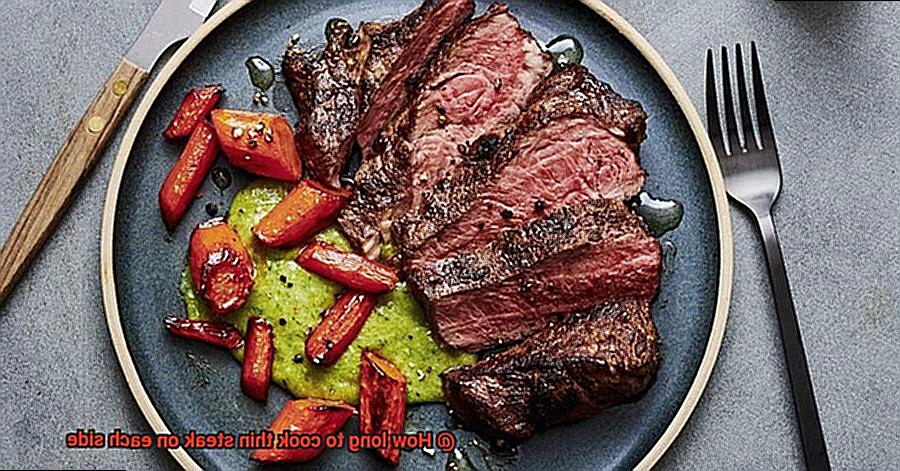
Next, we have the sirloin steak. This leaner cut still has a delectable flavor profile. To achieve a medium-rare steak, cook it for about 3-4 minutes per side. Be cautious not to overcook this cut as it can easily become dry.
If you’re feeling indulgent, then the filet mignon is the way to go. This incredibly tender and pricey cut of meat is worth every penny. Cook it for about 3-4 minutes per side for a medium-rare steak and savor its buttery texture and delicate flavor.
Now let’s move on to thinner cuts of meat. The flank steak is a versatile and quick-cooking cut that works well in stir-fries or fajitas. For a medium-rare steak, cook it for approximately 3-4 minutes per side and enjoy its bold flavor.
Finally, we have the skirt steak – a thin, flat cut that adds distinct flavor to Mexican dishes like carne asada. Cook it for about 3-4 minutes per side for a medium-rare steak and relish in its unique taste.
Remember that these cooking times are simply guidelines. Actual cooking time will depend on factors such as the thickness of the steak, the heat of your grill or pan, and personal preference for doneness. Always use a meat thermometer to ensure that your steak has reached a safe internal temperature before serving.
The Importance of Using a Meat Thermometer
Cooking the perfect steak can be both an art and a science. However, with the help of a trusty sidekick like a meat thermometer, you can achieve perfection every time. Whether you’re cooking a thick or thin steak, a meat thermometer is essential to ensure the steak is cooked to the desired level of doneness and is safe to eat.
Thin steaks, in particular, can be challenging to cook properly because they cook quickly and can easily become overcooked. But by inserting the thermometer into the thickest part of the steak and not touching any bones or fat, you’ll get an accurate reading of the internal temperature of the meat. This helps ensure that you cook your thin steak to the desired temperature while avoiding any undercooked or overcooked disasters.
According to the USDA, thin steaks should be cooked to an internal temperature of 145°F for medium-rare, 160°F for medium, and 170°F for well-done. Without a meat thermometer, it’s easy to miss these temperatures and end up with either an undercooked steak that could contain harmful bacteria or an overcooked steak that is tough and dry.
Using a meat thermometer not only ensures that your steak is safe to eat but also guarantees delicious and juicy results. The thermometer takes the guesswork out of cooking and allows you to achieve the perfect level of doneness every time.
It’s also important to note that meat continues to cook after it’s removed from the heat source. This is called carryover cooking and can cause the internal temperature of the steak to rise by as much as 5-10°F. Therefore, it’s best to remove your steak from the heat source when it reaches an internal temperature of 135°F if you want it medium-rare. Let it rest for a few minutes before checking the final internal temperature with a meat thermometer.
Using a meat thermometer when cooking thin steaks is crucial. It ensures that you cook your steak to the desired level of doneness while keeping it safe to eat. Plus, it guarantees juicy and delicious results every time.
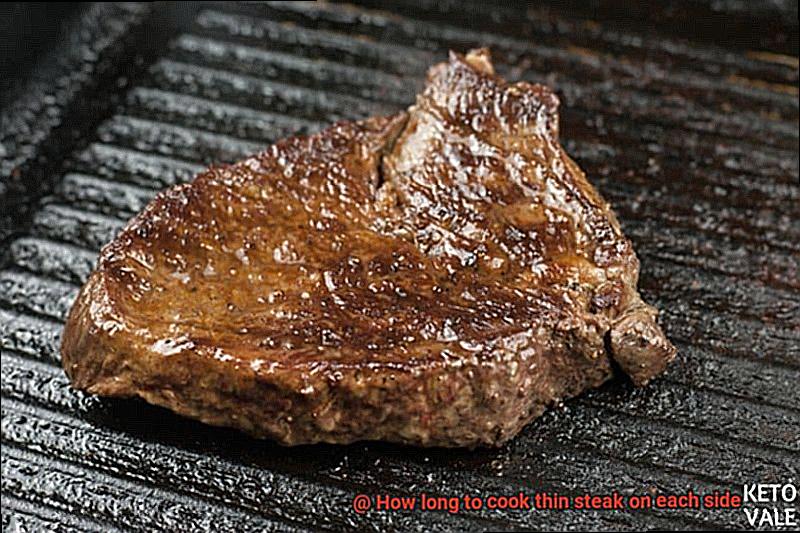
Tips for Perfectly Cooked Thin Steaks
Don’t let its delicate size intimidate you
with the right technique and timing, you can cook the perfect thin steak every time. Let’s dive into these seven tips for mouth-watering steaks that will leave you wanting more.
Bring the Steak to Room Temperature
Before cooking your steak, let it sit at room temperature for about 30 minutes. This will help it cook more evenly and avoid a cold center. Plus, it will make sure that your steak is perfectly cooked from edge to edge.
Season Your Steak
A well-seasoned steak is a delicious steak. Season your steak with salt and pepper on both sides before cooking. You can also experiment with other seasonings such as garlic powder or onion powder for an extra burst of flavor.
Preheat Your Pan
The key to a perfectly seared thin steak is a hot skillet or grill pan. Heat your pan over high heat until it’s very hot. This will create a nice sear on the steak and help it cook quickly. Don’t forget to use oil with a high smoke point like canola or vegetable oil to prevent burning.
Cook Your Steak for a Short Time
Thin steaks cook quickly, so keep an eye on them. For medium-rare, cook each side for 2-3 minutes. For medium, cook each side for 3-4 minutes. And for well-done, cook each side for 5-6 minutes. Remember to use a meat thermometer to check the internal temperature of your steak and aim for 135°F for medium-rare.
Let Your Steak Rest
After cooking your steak, let it rest for about 5 minutes before slicing into it. This will allow the juices to distribute evenly throughout the meat and make it more tender.
Common Mistakes to Avoid When Cooking a Thin Steak
Cooking a thin steak can be a bit of a challenge, and there are several common mistakes that people tend to make that can ruin the overall taste and texture of the meat. But don’t worry, we’ve got you covered. Here are some tips on how to avoid these pitfalls and cook the perfect thin steak every time.
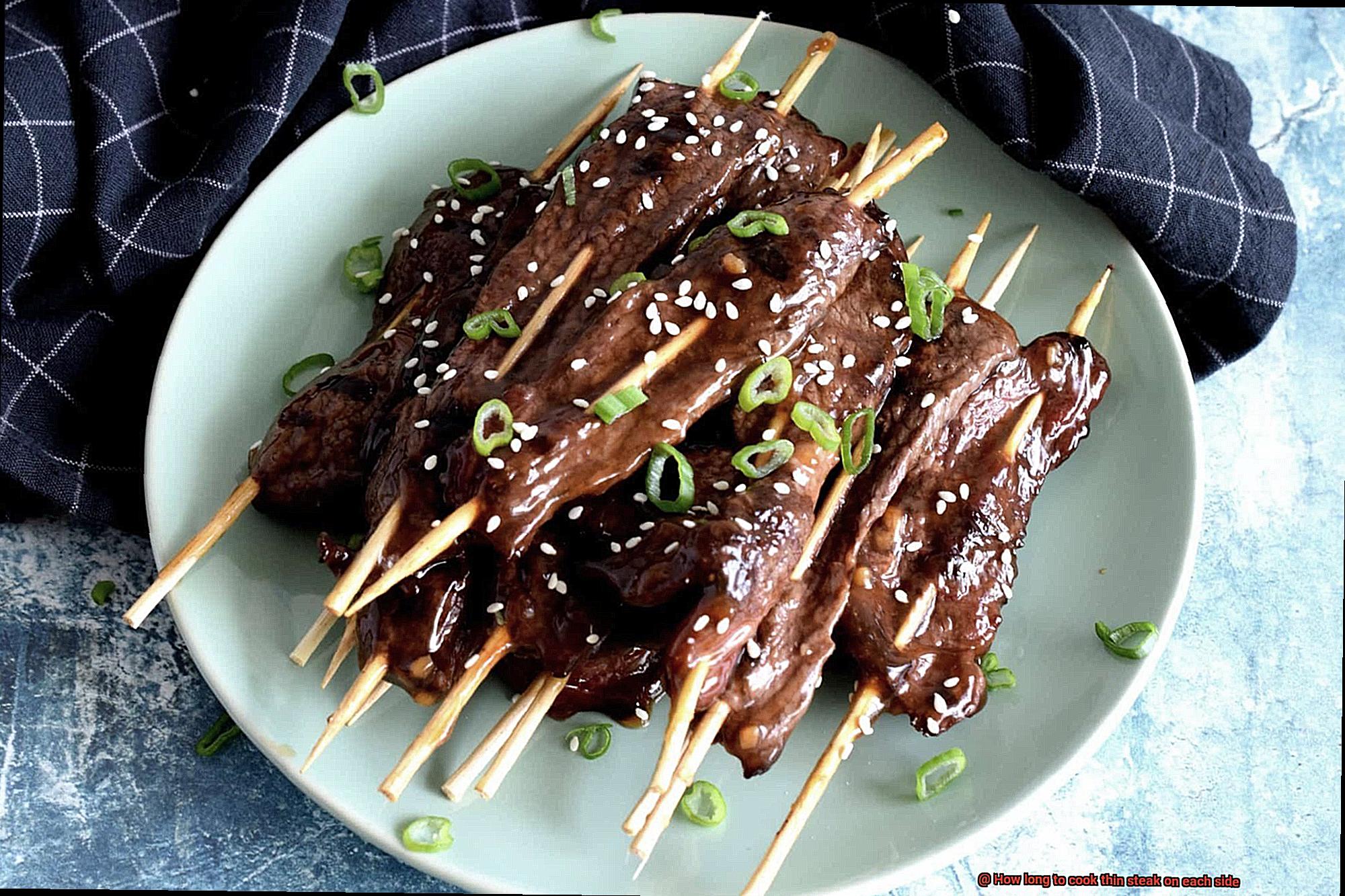
Firstly, don’t overcook your steak. This is one of the biggest mistakes people make when cooking a thin steak. Overcooking it can lead to a dry and tough result that is unappetizing to eat. To ensure that your steak is cooked perfectly, use a meat thermometer and keep a close eye on the steak while it’s cooking. This will help you achieve the desired internal temperature without overcooking it.
Another mistake that many people make is not letting the steak rest before serving. Allowing your steak to rest for a few minutes after cooking will help redistribute the juices, making it juicy and tender when served. Cutting into the steak too soon can cause all of the juices to escape, leaving you with a dry and unappetizing meal.
When it comes to seasoning your steak, it’s important not to go overboard. Using too much salt or seasoning on a thin steak can overpower the natural flavor of the meat. Instead, try using simple seasonings like salt, pepper, and garlic powder to enhance the natural flavors of the steak without overwhelming them.
Lastly, different cuts of steak may require different cooking times or methods than others. To avoid disappointment, be sure to do your research and select a cut of steak that is appropriate for your cooking method and level of experience.
Remember, cooking a perfect thin steak requires patience, attention to detail, and practice. But with our simple tips in mind, you’ll be well on your way to becoming an expert in no time.
-W72c6Sg61A” >
Conclusion
To cook the perfect thin steak, it’s important to take into account various factors such as thickness, temperature, seasoning, and cooking time. By mastering these techniques, you’ll be able to enjoy a succulent and mouth-watering steak every time.
Precision is crucial when it comes to cooking thin steaks. You don’t want to overcook or undercook your steak. The thickness of your cut of meat, the type of steak, and your personal preference for doneness are all essential considerations. Choosing a cut with some marbling will also add flavor to your dish. Don’t forget to use a meat thermometer to check the internal temperature.
The cooking time will depend on the method you choose. Grilling requires less cooking time because of the high heat from the grill. If you’re using a stovetop or oven with lower heat settings, you may need to increase the cooking time slightly.
To avoid common mistakes like overcooking or not letting your steak rest before serving, follow our tips such as using simple seasonings like salt and pepper and selecting an appropriate cut based on your experience level.

